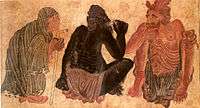Siyah Qalam
Mehmed Siyah Qalam[1] simply Siyah Qalam or Siāh-Qalam (Persian: سیاهقَلَم, Turkish: Siyah Kalem, meaning "Black Pen") comprise around 80 extant late 14th and early 15th century paintings folios, ink drawings (qalam-siāhi), and calligraphies, on various material, sometimes silk. Measuring up to 335 × 485 cm, they are generally attributed to Iran and bear the strong influence of Chinese art and techniques, as well as symbols of Buddhism and Shamanism, which were both major faiths in the region of Central Asia before the arrival of Islam.[2]

In tone and theme, the images are a highpoint of Persian draughtsmanship and include works from the Mozaffarid, Jalāyerid and Turkmen periods.[3] They are sometimes attributed to the notname Ustad Siyah Qalam; equivalent in English to the Master of the Black Pen.
The figures span a variety of cultures: Iranian, Turkic, Chinese, Mongolic, and date to the century after reign of the Turco-Mongol conqueror Timur. Notable for their intrinsic quality, they contain depictions of diabolic imagery, everyday nomadic life in the Euroasian steppe, and contemporary culture's relationship with the dead.
They are held at the Topkapi Saray Library, Istanbul; parts of the Diez Albums of the Berlin State Library are closely related.[2]
Illustrations

The more fantastical and intensely coloured[4] images seem to conjure the devastation and bleakness of Genghis Khan's reign.[5] The drawings have been described as evidencing the "brutal realism of the draftsmanship [while] the lyricism of the refined delineations is of such intensity that it has been matched only in isolated instances in Buddhist as well as Islamic paintings".[6] In general the inscribed text is banal and not of comparable quality to the illustrations, either in craft or meaning.[4]
The compositions are highly expressive, and a number of figures are engaged in ecstatic ritual or dance.[7] The fantastical monsters are drawn from local Pre-Islamic Central Asian folklore, bearing resemblance to beings of Indian, Chinese and middle Eastern legend as Central Asia lies on the cultural crossroad between the Middle East, South Asia and East Asia.[5] Many of the earthly scenes depict everyday life in the Central Asian Steppes as lived by various ethnic people, most prominent the Turkic and Iranian; washing clothes, blowing fire on a cooker, hanging lines of bows and arrows.[8] The living wear various head-dress and costumes and carry a variety of tools and weapons, and engage in different rituals.[5]
The miniatures bear the heavy influence of Chinese art, subtly in their sinuous lines and fluid rhythms, overtly in the figure's dress in that country's traditional dress. The works are of historical interest because of their depictions of everyday life of the faded world of historic Central Asia; with descriptions of tools, costumes, rituals, headdress, and the treatment of domesticated animals.[5]
The cultic acts, especially the ecstatic movement of the dancing figures, filled with emotion and vehement gestures, according to art historian Ingto Walther show "twisted limb and windining motifs...[and are contrasted by the]...brutal realism that overlies the virtuosity of draftsmanship, the lyricism of the refined delineation is of such intensity that it has been matched in isolated subsequent instances in Buddhist as well as Islamic painting".[5]
Iconography
The sources for the drawings are uncertain; various parts may be influenced by the Shahnameh and the biblical Solomon. In addition, given their often disparate size; their precise function cannot be determined with much certainty, though it might be that they were intended as aids to storytelling, to Royal elites.[3]
Provenance
The extant leaves are taken from a number of scrolls that transferred ownership during wars and land occupations. Leaves are recorded in inventories in Istanbul and in the library of Topkapi palace of Sultan Selim I as booty from his 1514 Persian adventure.[5]
Gallery
 Daily life of nomads, including men washing clothes, starting a cooking fire and carrying bows and arrows
Daily life of nomads, including men washing clothes, starting a cooking fire and carrying bows and arrows Study of Boars at battle
Study of Boars at battle Folio 90, recto; Performance Scene, African
Folio 90, recto; Performance Scene, African Folio; Demons, the dead and the living at battle
Folio; Demons, the dead and the living at battle Caravan
Caravan
References
Notes
- [ https://www.britannica.com/biography/Mehmed-Siyah-Kalem]
- Bloom; Blair, 21
- "Siāh-Qalam 'black pen" the genre of paintings or drawings done in pen and ink; the painters of such drawings". Encyclopædia Iranica. Retrieved 27 September 2015
- Bloom; Blair, 225
- Walther, 254
- Walther, 254-5
- Robinson, 37
- Walther, 255
Sources
- Bloom, Jonathan, Blair, Sheila (eds). Grove Encyclopedia of Islamic Art & Architecture. Oxford: Oxford University Press, 2009. ISBN 978-0-1953-0991-1
- Robinson, B.W. Persian Book of Kings: An Epitome of the Shahnama of Firdaws. Routledge, 2012. ISBN 978-0-7007-1618-0
- Walther, Ingo. Codices Illustres. Berlin: Taschen Verlag, 2001. ISBN 978-3-8228-6023-6